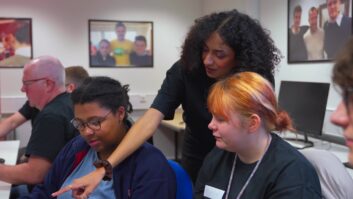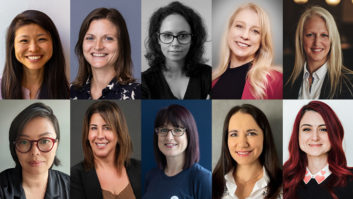
The days of training schemes in broadcast engineering have disappeared. Dick Hobbs talks to the IABM’s Roger Crumpton to find out how the industry vendor body aims to get technology training back onto the digital media industry agenda.
Not so long ago, most of the big broadcasters had internal training schemes that created the large numbers of engineers the industry required. Some made a career within the broadcaster, some left to work with manufacturers to create new products. But one of the significant downsides of the recent transformation of the industry is that these training schemes have all but disappeared – and unsurprisingly we now find ourselves with a critical shortage of engineering talent.
While everyone recognises this as a problem, the IABM (the body which represents the interests of manufacturers and suppliers) has taken action. Former director-general Roger Crumpton has been appointed its new director of education, employment and training.
He makes the point that his three-faceted job title reflects the challenges which the industry faces. “There is a continuum from 15 to 65,” he says of the training and development problem. “It goes back as far as school: there are issues with entrance to colleges and universities, with the link between universities and employers, with induction and how people get oriented to the industry. And there is an absence of continuing professional development.”
Crumpton embarked on a programme of research in 2010, talking to manufacturers, broadcasters and universities around the world. His report to the IABM board resulted in them setting up a three year programme of investment and development.
While he acknowledges the delicacy of the matter, he emphasises the key shift in training provision. “Most of the technical people who lead the industry today benefited from an education and training regime when they came into the industry that was arguably very well structured and probably world class. Most of them have either been involved in the disbanding of it or have watched it disband.
“I am not saying that to try to shame people,” he continues. “I am saying it to make them sit up and pay attention, because there really is something wrong if they have actually managed – intentionally or by neglect– to allow that whole framework of developing engineering talent to gradually dismember. And the industry needs to do something to bring it back.”
His view is that the problem starts at school and the study of mathematics. Educational systems vary, but in the UK and North America the compulsory study of maths ends at 16, which means decisions taken at the age of 15 can remove you from the potential talent pool. So creating awareness of the excitement and challenges of working in broadcast engineering has to start young.
“There are a number of universities and colleges, across Europe, which run what we can call ‘digital media engineering oriented’ undergraduate studies,” Crumpton explains. “What is really intriguing is that almost all of them have full employment as an outcome – the graduates nearly all get jobs.
“But while they might have full employment, in many cases they only have perhaps 30% of the places taken up,” he adds. “They have an input problem. One reason is that the pool of qualified applicants is not there is because the educational system is not producing them.
“The second reason is that universities tend not to recruit: people tend to apply. There is very little merchandising of the courses and what they mean for a career afterwards. Specialisations like digital media engineering tend to get lost behind the more conventional choices of IT systems or software engineering.”
In a conversation that was otherwise largely concerned with “challenges” and “issues”, Crumpton did have some cheer on this issue. “The good news is that we are talking here about hundreds of specialist graduates, not thousands. If the industry is short it is by a few hundred graduates – the solution is realisable.
“If an individual broadcaster or supplier adopted one school, ran some programmes and encouraged 10 students to think about the industry, and that happens with lots of companies and lots of broadcasters, then suddenly the pool of availability would sort itself out. This is not a problem of unmanageable proportions.”
Focusing on recruitment
Raising enthusiasm at school and directing people to the right degree courses leads to the next challenge: graduation. Here Crumpton points the finger at recruitment. “The broadcast and media sector does not go looking for the best talent,” he says. “The most talented engineers end up at Cisco or Microsoft or Apple, because those companies build relationships with universities, and the senior lecturer rings them up and says ‘in my cadre this year I have two or three students who are really hot’.
“What the media technology sector has not done – with a few exceptions – is let the best talent know about this very secretive industry where there are lots of really ritzy roles. If you are going to put the infrastructure into Formula 1, or a presidential election, or the multi-platform delivery of the Olympics, or X Factor or whatever it is, there are some really glamorous roles in there.
“People in universities do not see that. They find the opportunities at IT companies sound more exciting!”
There is clearly a need for more engagement between employers and academia. That includes work experience and placements, final year projects, company tours, open days, and more. To drive that engagement the IABM is appointing an educational liaison officer, charged with building relationships.
It is also establishing a brokerage operation for placement opportunities and work experience. “A company can come to us and say ‘we are thinking of maybe taking on a couple of student placements for graduates: can you put us in touch with people who might have some interesting candidates.’ And also get the universities to come to us and say ‘we have got these five really talented people and we think someone ought to take a look at them’.”
The third element of this bold programme is a look at continuing professional development. Very little exists today in our industry, so in consultation with broadcasters and vendors the IABM is developing its own set of courses. They are pitched at three levels: entrant, engineer and expert.
“At entrant level we are talking about both technologists and non-technologists – people whose job function touches technology without having to develop it or use it,” Crumpton explains. “People in procurement in broadcast, maybe people who are in marketing communication roles at suppliers. They have to know what a router is: even if they do not need to know how it works or how to use it.”
The offer is a measured, step-by-step entry, with two new programmes to be introduced every six months over the next three years. The first will appear in the second quarter of 2011. In most cases there will be two versions of the course: a classroom, instructor-led version and an online, self-paced version.
“The programmes we are looking at will typically be short duration, high intensity – maybe two days and 10 teaching hours, with the goal to make people aware of the technology and give them the opportunity to understand it,” he says. “We are seeking to stay within a sensible budget for the employer that says ‘I have a graduate electronics engineer here who will be working on a product who has to understand the fundamentals of audio and video for it to be fit for purpose’.”
These courses will be delivered by instructors on behalf of the IABM itself, but will also be made available for delivery partners around the world. Some of these may be commercial trainers, some will be industry associations. They will provide local language versions but they will fundamentally be the same courses.
“We want everyone to understand what a ‘qualified broadcast engineer’ is, not in terms of where he or she comes from but what are the competencies that they need to have,” Crumpton says. “One facet of this – that is a long way off at the moment – is some form of testing and certification capability. Infocomm has done a good job of that in the AV industry. They started in the early 1990s and they have made a difference. That is a good role model.”
The development of a new team to develop and oversee industry-specific education and training, and the creation of 10 or 12 (in the first instance) practical courses looks like a significant investment for the IABM. Roger Crumpton agrees: “I have been impressed by the willingness of the IABM board to say this is a long-term structural issue for the industry, and take a significant stance on training.
“They have made money available from the reserves to make that long-term commitment,” he continues, adding that it was not a bottomless pit. “We have to do it on some form of commercial basis. We are a not-for-profit organisation but we do have to try to recover the money we are investing so we can invest more in new programmes. It has to make economic sense, but the pump priming fund is something that the IABM has decided to make available on an exceptional basis.
“If this problem is really to be solved we need leadership behaviour from broadcasters, from the broadcaster organisations, from individual suppliers and from other industry organisations. This is a global problem: the situation has been deteriorating for many years, and this is a long-term fix,” Crumpton concludes.
“What we as the IABM are trying to do is take our part and help others do their bit, working with the industry as a whole to make a difference.”






